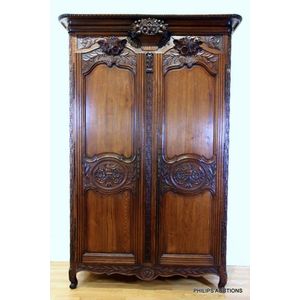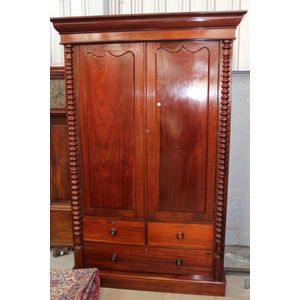Georgian Mahogany Corner Cabinet
You must be a subscriber, and be logged in to view price and dealer details.
Subscribe Now to view actual auction price for this item
When you subscribe, you have the option of setting the currency in which to display prices to $Au, $US, $NZ or Stg.
- Proportions - Essentially, the size of the various parts of a piece of furniture in relation to the whole. Ideally, the proportions should be pleasing to the eye appearing neither top-heavy nor unbalanced and convenient for ordinary use.
- Mahogany - Mahogany is a dense, close grained red-coloured timber from the West Indies and Central America. It was first imported into Europe in the the early 18th century and its use continued through the 19th century. It was popular for furniture making because of its strength, the wide boards available, the distinctive grain on some boards, termed flame mahogany and the rich warm colour of the timber when it was polished.. The "flame" was produced where a limb grew out from the trunk of the tree, and this timber was usually sliced into veneers for feature panels on doors, backs and cornices.
Some terms used to describe mahogany relate to the country from which it originally came, such as "Cuban" mahogany, "Honduras" mahogany etc. However unless the wood has been tested the names assigned are more a selling feature, rather than a true indication of the timber's origin. - Cornice - The upper section of a high piece of furniture such as a bookcase, wardrobe or cabinet that sits immediately on the main structure. The cornice is usually decorated with a variety of architectural mouldings, worked either with a moulding plane or, from the later 19th century, by machine. The front and side of the cornice are mitred together, strengthened by glue blocks, and the back is generally a simple dovetailed rail to hold the structure together. Cornices are generally, though not always, fitted separately to the piece and are held in place either by screws sunk into the top board or by wooden corner blocks. A pediment may sit above the cornice, but sometimes the terms cornice and pediment are used interchangeably.
- Plinth - The square or rectangular base of a piece of cabinet furniture, often ornamented with moulding. The plinth may be separate, as in some wardrobes or presses, and act as the support for the carcase. In a false plinth, the moulded boards may be attached directly to the piece. Furniture with a plinth base usually does not have separate feet. The term derives from architecture where it denotes the base of a column or statue.
- Canted Corners - In decorative arts, especially furniture making, a canted corner refers to a technique where the corner of the piece is angled or "canted" to create a diagonal corner. This is different from a chamfered corner which is a technique where the edges of a corner are cut at an angle, creating a diagonal edge or "bevel" along the corner.
A canted corner is typically used to add visual interest to the item. It can be found in various styles of furniture such as contemporary, Art Deco, or traditional. It is often used to create a sense of movement and dynamism in a piece.
Canting a corner is a more complex technique than chamfering, and it is typically done by tilting the corner of a piece of furniture and then cutting the wood to match the angle. It's a technique that requires precise measurements and a good understanding of angles and geometry, and it is usually done by experienced artisans. - Dentil Moulding - An architectural ornamental feature found on furniture, usually directly beneath the upper mouldings on a cornice. The timber is cut in a series of deep rectangular sections, alternatively raised and flat, like the crenellation on a castle battlement. In appearance not unlike a row of small teeth. From the latin "dens", teeth. Most commonly seen on bookcases, chests and cabinets, and less frequently on desks and wardrobes.
- Georgian - As an English stylistic period, Georgian is usually taken to cover the period from George I (1714) to the Regency of Prince George (1811-20), although the period from 1800 to 1830 is sometimes designated as the Regency period. During the Georgian period the great English cabinetmakers and designers such as Chippendale, Hepplewhite, Adam Sheraton etc., were all active.
Therefore there isn't a single 'Georgian style' as such and to say something is 'Georgian', usually means it was made between 1714 and 1830. This assumes we discount George V and George VI, both being from the 20th century.
The styles popular at the time of each reign were:
George I (1714-1727) saw out the last years of the Baroque period.
George II (1727-1760) reigned during the Rococo period.
George III (1760-1820) saw the last gasp of the Rococo, all of the early Neo-Classic 'Adam style' and most of the later neo-Classic 'Regency style'.
George IV (Prince Regent 1820-1830)encompassed the last of the 'Regency' style.
William IV's reign (1830-1837) was something of a no man's land (stylistically) and he wasn't a 'George' anyway. He covered the last glimmerings of 'Regency' and the start of the 'Victorian' style.
This item has been included into following indexes:
Visually similar items

A birch veneer television cabinet in the Beidermeier style, 20th century, America, made by century furniture, in an architectural style, open at the back and with two doors opening to a movable base for a television set, above two cupboards with lion head

A French provincial oak Marriage armoire, 19th century, with an extended cornice centred with a basket of flowers in high relief, a pair of long doors with shaped fielded panels, with carved flower posies and central medallions with arabesques and pairs of

A large French elm armoire, circa 1780 the shaped and moulded cornice above two panelled doors, 167 cm wide

19th century double cedar wardrobe with half bobbin supports three drawer to base shield panel doors, internal mirror
